Sustainable Design Awards Toolkit
Section 4 - Inspirational Current Work
 |
Download the toolkit sections 3 & 4 here.
File size 3.66MB - Download time via a 56 modem 9 mins. [approx].
|
Introduction
Much of the responsibility for change lies at the
designers' doorstep. Many companies have started incorporating more
sustainable ideas into their current design work and plans for the
future. But what are the drivers for designers in other companies
to follow in the footsteps of the likes of 'Remarkable' and 'Phillips'
to include sustainability issues into their designs?
'Global temperatures across the world are rising faster than ever before'
1) To improve the environment for future generations
'More than 100 million people live in cities where the air is unsafe to breathe'
2) Rising customer and consumer demands
'In the last ten years, environmental disasters have resulted in over �600
billion worth of damage, more than in the previous four decades combined'
3) The demands from manufacturers
'The economy uses about 50% of the earth's natural production per year'
4) Competition from other companies and emerging technology
'Continuing to burn fossil fuels at current rates will result in greenhouse gases
increasing by 50% within 15 years, risking catastrophic climate shifts'
5) Present and forthcoming legislation
'The number of pupils studying Design and Technology at GCSE level has increased
by 7.6% over the last three years'
6) Because of inspirational current work?
|
Section 4.1 - Inspiration

This 'Spacepen' from Fisher illustrates a current
product that considers durability, it's able to write for over 30
miles, that equates to over 80 years worth of ink for the average
user.
Battery company Energizer (www.energizer.com),
have recognized that batteries can be a problem when it comes
to sustainability. The batteries' disposal would seem to be
the main problem area with most batteries having a bad environmental
impact, furthermore most portable handheld products need the
use of batteries at present. Sustainable design and redesign,
as it stands, is not about making ev erything
totally sustainable, that would be impossible, but more about
improving the current climate of design and hoping that the
benefits of using more sustainable methods in the future outweigh
the use of non-environmental products. erything
totally sustainable, that would be impossible, but more about
improving the current climate of design and hoping that the
benefits of using more sustainable methods in the future outweigh
the use of non-environmental products.
Energizer are in the category of a company seeking a more sustainable
product. One method is phasing out the use of mercury in batteries.
Energizer have achieved this by a disposable mercury free battery
design that althoughnot rechargeable, meets current EPA disposal
requirements. Sanyo are another company that have developed
these mercury free batteries with a more environmentally friendly
alkaline equivalent, with the aim of achieving a longer lasting,
more durable battery.
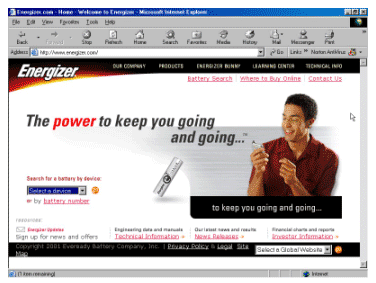
Both companies are now producing rechargeable batteries that
aid this. Obviously the lifespan is improved, with any one battery
lasting for over 1,000 charges. Thus the emphasis is on reuse
and lifespan rather than redesigning a whole product without
a battery.
More information on the Energizer battery can be gathered from
their website - www.energizer.com.
|
Cyclic Products
Many current design projects are starting to
consider the issue of cyclic 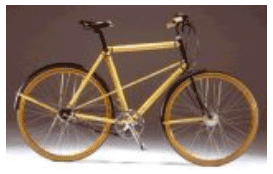 design,
considering recyclable materials when looking at material selection.
Bicycle designers 'Hermes' have taken on this idea of cyclic
products and are now producing bicycles made from rattan and
bamboo. They're also making use of other natural resources such
as wood, leather and wool, making their design more compostable. design,
considering recyclable materials when looking at material selection.
Bicycle designers 'Hermes' have taken on this idea of cyclic
products and are now producing bicycles made from rattan and
bamboo. They're also making use of other natural resources such
as wood, leather and wool, making their design more compostable.
This watch from 'Mondaine' is made totally 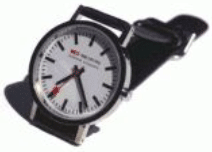 from
post-consumer brass. Any glass, metals or polymers used on the
watch are recyclable making the product cyclic. from
post-consumer brass. Any glass, metals or polymers used on the
watch are recyclable making the product cyclic.
Improving a product's sustainability is often thought to be
solved by just making the product recyclable. Sure, that is
one aspect, but much of the sustainability is about seeking
more environmental methods to achieve the same or improved functional
outcome. Sustainable design is centred around changing people's
perspectives, opening their eyes to alternative methods. It
doesn't always have to be like that.
Seiko (www.seikowatches.com)
are a company that are taking their watch designs that one-step
further by introducing kinetic watches at the upper end 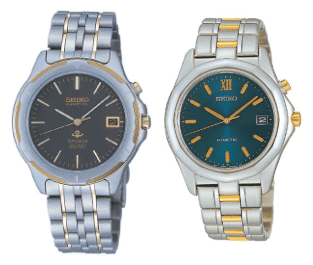 of
their market. As well as being water & splash resistant, made
from light titanium, Seiko have pushed the concept of a watch
that is powered simply by the movement of the wearer, requiring
no battery, so instead of progressing the product's recyclability
they are improving its energy efficiency by seeking alternative
methods. of
their market. As well as being water & splash resistant, made
from light titanium, Seiko have pushed the concept of a watch
that is powered simply by the movement of the wearer, requiring
no battery, so instead of progressing the product's recyclability
they are improving its energy efficiency by seeking alternative
methods.
�

|
|
|
 
 |
Inspirational Current Work
|
 |
�
|
 |
Toolkit Index

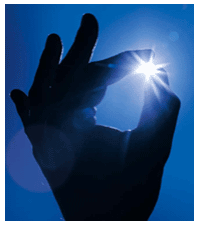
|
|




 erything
totally sustainable, that would be impossible, but more about
improving the current climate of design and hoping that the
benefits of using more sustainable methods in the future outweigh
the use of non-environmental products.
erything
totally sustainable, that would be impossible, but more about
improving the current climate of design and hoping that the
benefits of using more sustainable methods in the future outweigh
the use of non-environmental products.
 design,
considering recyclable materials when looking at material selection.
Bicycle designers 'Hermes' have taken on this idea of cyclic
products and are now producing bicycles made from rattan and
bamboo. They're also making use of other natural resources such
as wood, leather and wool, making their design more compostable.
design,
considering recyclable materials when looking at material selection.
Bicycle designers 'Hermes' have taken on this idea of cyclic
products and are now producing bicycles made from rattan and
bamboo. They're also making use of other natural resources such
as wood, leather and wool, making their design more compostable. from
post-consumer brass. Any glass, metals or polymers used on the
watch are recyclable making the product cyclic.
from
post-consumer brass. Any glass, metals or polymers used on the
watch are recyclable making the product cyclic. of
their market. As well as being water & splash resistant, made
from light titanium, Seiko have pushed the concept of a watch
that is powered simply by the movement of the wearer, requiring
no battery, so instead of progressing the product's recyclability
they are improving its energy efficiency by seeking alternative
methods.
of
their market. As well as being water & splash resistant, made
from light titanium, Seiko have pushed the concept of a watch
that is powered simply by the movement of the wearer, requiring
no battery, so instead of progressing the product's recyclability
they are improving its energy efficiency by seeking alternative
methods.